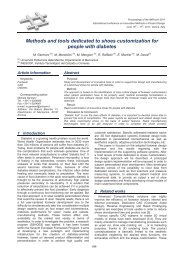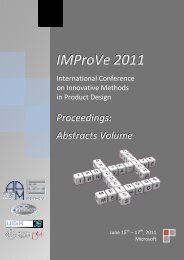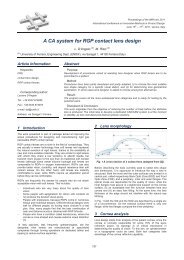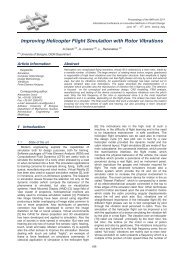IMProVe 2011 - Proceedings
IMProVe 2011 - Proceedings
IMProVe 2011 - Proceedings
Create successful ePaper yourself
Turn your PDF publications into a flip-book with our unique Google optimized e-Paper software.
Teaching Product Design and Drawing History<br />
CAD, BIM, GIS and other tricks of the computer science<br />
in the education of the Building Engineer<br />
G. N. Massai (a), M. M. Bocconcino (a)<br />
(a) Politecnico di Torino – I Facoltà di Ingegneria<br />
Abstract:<br />
Purpose:<br />
The paper aims to develop some thoughts on the upgrade implemented in the disciplines<br />
of drawing from the latest forms of digital representation, commenting on the<br />
experiences under way in some university courses included in the learning curriculum<br />
provided to engineering students with regard to the course of study in Ingegneria Edile<br />
(Building Engineering, also known as Architectural or Construction Engineering) at the<br />
Politecnico di Torino. It’s a matter of reasoning on what and how to suggest knowledge<br />
and practises in the experience of teaching that result as an improvement of skills and<br />
abilities appropriate for future commitments required by the job world.<br />
Method:<br />
Methodological reasons, subject contents and experiences positively carried out during<br />
the activities of the course of Representation Techniques and Data Management (in the<br />
post graduate “Laurea Magistrale”) are treated, focusing on all the resources needed to<br />
conduct profitable operations training and first clarifying the specific skills and experience<br />
required for the teaching staff, essential qualities to ensure good results: all the activities<br />
organized to achieve the training objectives are based on the belief that early training is<br />
needed to trigger virtuous review processes for engineering practice and that<br />
opportunities to practice through simulations in the academic curriculum for future<br />
engineers can produce effects of greater permanence and enable an enhancement of<br />
learning outcomes.<br />
Result:<br />
The analysis, which is addressed primarily to illustrate the result of some of the outcomes<br />
of exercise activities leaded by students, brings attention to a solicitation that seems to be<br />
constraining and that concerns the system of relations required between operators of the<br />
design and construction process, which are requested to enter into shared aims while<br />
operating in the specificity of the various technical fields; in this sense, the tricks of the<br />
CAD, which is at the service of a geometric knowledge, measured and fulfilled by its<br />
attributes, the attention demanded by BIM, which builds a widespread and open network<br />
of relationship, the cunnings of the GIS, which has to gather dynamic information and<br />
alternative choices, appear to address areas of operational testing following a single<br />
purpose directed towards a better characterization of the process of conceptual<br />
development and a more advantageous control of the working method.<br />
Discussion & Conclusion:<br />
So, with the design and over the usual representations, we speak of computer tricks to say<br />
that to be understood as the necessary infrastructure to solicit and investigate the reasons<br />
of doing and how to solve the complexity of operating on the field, upon which students<br />
must impractical themselves to identify qualities and limits, whether they are exploring<br />
134<br />
June 15 th – 17 th , <strong>2011</strong>, Venice, Italy<br />
<strong>IMProVe</strong> <strong>2011</strong> - <strong>Proceedings</strong>










